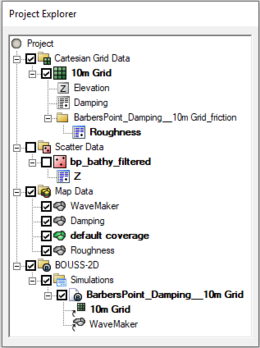SMS:BOUSS-2D Simulations: Difference between revisions
No edit summary |
No edit summary |
||
| Line 3: | Line 3: | ||
To create a new Simulation: | To create a new Simulation: | ||
# Right-click on empty space in the project explorer and select ''New Simulation''|'''BOUSS-2D''' | # Right-click on empty space in the project explorer and select ''New Simulation'' | '''BOUSS-2D''' | ||
# Drag and drop bouss2d grid, wave maker/damping/porosity coverages under the newly created '''Simulation''' tree item. | # Drag and drop bouss2d grid, wave maker/damping/porosity coverages under the newly created '''Simulation''' tree item. | ||
A New tree item will appear | A New tree item will appear | ||
Revision as of 15:42, 11 May 2015
Simulations are available in BOUSS-2D starting in SMS 11.2. A simulation should contain a BOUSS-2D grid, a wave maker coverage, and optional damping and porosity coverages. Right-clicking on the simulation will display the options and dialogs.
To create a new Simulation:
- Right-click on empty space in the project explorer and select New Simulation | BOUSS-2D
- Drag and drop bouss2d grid, wave maker/damping/porosity coverages under the newly created Simulation tree item.
A New tree item will appear
Menu Commands
Right-clicking on the simulation tree item will display a list of menu commands and dialogs that are available. These items are:
- Generating Arcs along land boundary – open a dialog that will create arcs in a damping or porosity coverage from an existing grid or scatterset.
- Generating Arcs along open boundary – open a dialog that will create arcs in a damping or porosity coverage from an existing grid or scatterset.
- Calculators
- Spectral Energy
- BOUSS-2D ProbesProbe Manager
- Model Control
Output Options
The user can instruct BOUSS-2D to create a variety of output files. These may include spatially varied data consisting of a value for each cell in the grid, transient data defining time series at a location, or a combination of these two options (multiple time steps of data that includes a value at each cell). The output options, along with the keyword included in the parameter file to enable these options are shown below.
- Steady-state/single value spatially varied datasets
- Significant wave height (":HS_FILE")
- Mean currents (":MEAN_UV_FILE")
- Mean wave direction (":THETA_FILE")
- Transient spatially varied datasets. Each output includes data from a specified start time, to a specified end time at a specified time step.
- Water surface elevations (":SAVE_ETA_ANIMATION")
- Transient currents (":SAVE_UV_ANIMATION")
- Time series output at specified cells (probes). BOUSS-2D saves each type of data (for multiple locations) in a single "*.ts1" file.
- Water surface elevations (":TS_ETA_FILE")
- Currents (":TS_U_FILE", ":TS_V_FILE") – This saves the current at a specified elevation up from the bed. Multiple elevations can be monitored.
- Pressure (":TS_PRESSURE_FILE") – This saves the pressure at a specified elevation up from the bed. Multiple elevations can be monitored.
- Flow rate (":TS_Q_FILE" – This saves the flow crossing a location and can be used for overtopping.
The spatially varied data may be output in to either BOUSS-2D native files or a eXtensible Data Format File (XMDF). If BOUSS-2D format is specified, the model creates "*.grd" files for each of the single value spatially varied outputs and binary data files for the transient data. The ":SOLUTION_FILE_OPTION" in the par file instructs the model to save the data in BOUSS-2D format (if set to 0), XMDF format (if set to 1) or both formats (if set to 2). When the XMDF option is specified, the ":XMDF_SOLUTION_FILE" record must also be in the parameters file along with the name of the XMDF file to store the datasets in.
The output options are located in the model control.
- Model Check – The model check will warn the user of potential errors that should be considered for fixing before running the model.
- Exporting – When the BOUSS-2D files are exported a new directory under the project called “BOUSS-2D” is created. In this directory, the grids will be written to. Also a new directory under the “BOUSS-2D” will be created and it will be the name of the simulation. In this directory, the *.par file(link to Parameter file) can be found.
- Running the model
Related Topics
SMS – Surface-water Modeling System | ||
|---|---|---|
| Modules: | 1D Grid • Cartesian Grid • Curvilinear Grid • GIS • Map • Mesh • Particle • Quadtree • Raster • Scatter • UGrid |  |
| General Models: | 3D Structure • FVCOM • Generic • PTM | |
| Coastal Models: | ADCIRC • BOUSS-2D • CGWAVE • CMS-Flow • CMS-Wave • GenCade • STWAVE • WAM | |
| Riverine/Estuarine Models: | AdH • HEC-RAS • HYDRO AS-2D • RMA2 • RMA4 • SRH-2D • TUFLOW • TUFLOW FV | |
| Aquaveo • SMS Tutorials • SMS Workflows | ||
